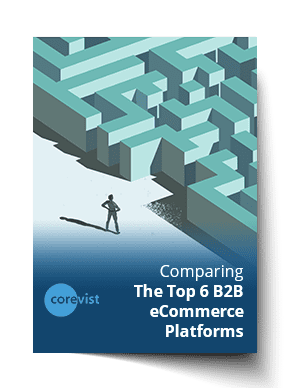Share
Author
George Anderson
Share
If you’re looking for an eCommerce solution integrated to SAP, BigCommerce looks like a great option. The platform is quite robust for B2C. If you’ve already launched BigCommerce for a proof of concept in B2B, the idea of integrating with SAP ECC may be attractive.
In B2C scenarios, it makes sense to integrate BigCommerce to SAP ECC. But in B2B scenarios driven by complex SAP business rules, there are a few caveats you should consider before you go down this path.
These potential issues arise from the fact that you have only two options for integration architecture in a BigCommerce/ECC scenario.
Options for integrating BigCommerce and SAP ECC
Because BigCommerce doesn’t offer built-in integration to SAP ECC, both options for integration require duplication and synchronization of data across three total systems. Here’s what that looks like in each case.
Middleware that’s maintained by your IT team
This scenario creates a significant resource burden for your IT team, as they will have to maintain a third system (middleware) that synchronizes data and logic between BigCommerce and SAP ECC.
This architecture also introduces risks to data integrity, as the three systems (BigCommerce, middleware and ECC) must be kept perfectly synchronized. Problems here can lead to a bad customer experience and customer abandonment of B2B eCommerce.
iPaaS (integration platform as a service) that’s managed by the iPaaS vendor
This scenario creates a far lower burden for your IT team. However, this architecture still fundamentally treats BigCommerce and SAP ECC as separate systems that must be synchronized. Because a third party is responsible for keeping the integration software aligned with systems that you control (ECC and BigCommerce), this architecture also introduces risks to data integrity and customer experience.
Caveats to integrating BigCommerce and SAP ECC
As you can see, both options for integrating BigCommerce and SAP have potential negative consequences. If you’re going to integrate these systems, you’ll move away from having a single source of truth (SAP ECC) to having three sources of truth (SAP, BigCommerce and your integration software). You’ll have to keep these systems in harmony with each other and synchronize them regularly.
Ultimately, that introduces risk and complexity to your data management.
The potential impact is much lower in a B2C scenario, where you don’t have complex, personalized business rules for each customer. But in a true B2B scenario (for example, a manufacturer selling to their channel partners through BigCommerce), the potential impact is much higher. When something changes in your business rules, what are the ripple effects across other systems? How will these data problems affect your customer experience? Can you even foresee these ripple effects today?
This is why we recommend looking carefully at your SAP ECC business rules and how your customer experience depends on them. In fact, this consideration is so important, you should use it to evaluate potential B2B eCommerce platforms.
FREE Chart
Compare Top 6 B2B Platforms
Find your best fit based on revenue size, complexity, and depth of SAP integration required. Compare SAP Commerce Cloud, Salesforce B2B Commerce, and more.
Can’t you get a tighter, more reliable integration between BigCommerce and ECC?
Because BigCommerce wasn’t built on an integration to ECC, middleware and iPaaS really are your only integration choices. Unfortunately, neither option can turn BigCommerce into a comprehensive, real-time reflection of your SAP ECC data and logic.
Yet some organizations require this depth of integration — both for internal data harmony, and for a personalized customer experience.
So how do you know if BigCommerce is a good fit for your SAP ECC integration scenario?
Determining whether BigCommerce will work in your situation
Since it’s not possible to get BigCommerce to act as a comprehensive, real-time window into your SAP ECC system, you need to evaluate your customers’ needs for real-time integration. Ask yourself if your buyers need any of these features.
- Real-time inventory availability — including personalized ATP (available to promise) quantities, if applicable.
- Real-time, dynamic, personalized pricing — including quantity bundling rules and contract-based logic.
- Real-time requested delivery date logic — so customers can only see the requested delivery dates that are defined in SAP ECC.
- Intelligent SKU substitution — so customers get equivalent SKUs if they try to order something that’s not available to them.
- Real-time error messaging based on SAP ECC business rules — so customers can build well-formed orders through self-service, without having to call customer service.
- Real-time order posting to SAP — so customers have confidence that their order has claimed the inventory they need.
- Real-time order status and full order history — including orders from all channels (EDI, phone, fax and email), not just B2B eCommerce.
- Real-time credit status — so customers know whether their order will go on credit block.
- View and pay open invoices — so customers can keep their account in good standing.
Each of these features requires comprehensive, real-time integration to SAP ECC. BigCommerce will struggle to deliver them under both the middleware and iPaaS models.
If your customers require any of these features, you may want to think carefully before integrating BigCommerce to SAP ECC. Other B2B eCommerce platforms may offer a better fit for your use case.
Alternatives to integrating BigCommerce and SAP ECC
If you need deep integration to SAP ECC, you should evaluate BigCommerce alternatives. Depending on your revenue size, you may find a better fit in a platform like Corevist Commerce or SAP Commerce Cloud.
The big question is how much of that SAP integration you want to own.
To determine your appetite for owning that complexity, and to compare B2B eCommerce platforms from that perspective, download our FREE chart.
FREE Chart
Compare Top 6 B2B Platforms
Find your best fit based on revenue size, complexity, and depth of SAP integration required. Compare SAP Commerce Cloud, Salesforce B2B Commerce, and more.










